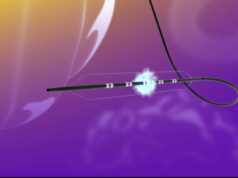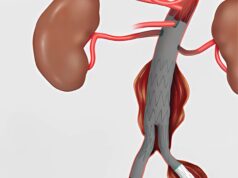
Results have been announced from two trials that were comparing carotid endarterectomy versus stenting for the treatment of carotid artery stenosis. As previously announced the Endarterectomy Versus Angioplasty in patients with Symptomatic Severe carotid Stenosis (EVAS-3S) following concerns regarding the stenting arm of the trial. The Stent-protected Percutaneous Angioplasty of the Carotid vs. Endarterectomy (SPACE) was stopped after recruitment of 1200 patients as statisticians had calculated that with even 1900 patients the chance to prove equivalence would have been only 50% rising to 80% if the study recruited 2500 patients.
The EVA-3S trial was a multi-centre, randomized, non-inferiority trial, that was evaluating whether stenting is not inferior to endarterectomy concerning (a) the risk of stroke or death within 30 days of procedure and (b) the long-term risk of ipsilateral stroke, in patients with recently symptomatic, severe carotid stenosis. The primary end point was a composite of any stroke or death occurring within 30 days of treatment. Secondary outcomes included: myocardial infarction; transient ischaemic attack; cranial nerve injury, major local complications and systemic complications.
Full results were presented by Jean-Louis Mas, Sainte-Anne Hospital, Paris, France, at the recent European Stroke Conference. Brief highlights of the results were presented at the European Vascular Course, Amsterdam, the Netherlands, by Professor Alain Branchereau, Paris, France, The study enrolled 527 patients (265 in the stenting arm; 262 in the surgical arm) at 31 centres. Thirty-day results showed that the risk of stroke or mortality was significantly increased in the stenting group compared with the endarterectomy group (3.9% vs. 9.6%, respectively; P=.01). In addition, stenting showed a significantly lower risk for cranial nerve injury (10.4% vs. 1.5%), and a beneficial trend for systemic complications (3.1% vs. 1.9%;) but a much higher risk for both major local complications (1.2% vs. 3.1%) and TIA (0.8% vs. 2.3%).
In September 2005, the Safety Committee recommended to stop inclusions into the trial because of safety concerns. In particular, the Committee said the benefit in favour of the surgical arm means that any further enrolment would be futile.
The SPACE-trial was a multicentre, prospective, randomized trial in Germany, Austria and Switzerland. The study was designed to test the hypothethsis that carotid artery stenting and carotid endarterectomy are equivalent in treating patients with symptomatic carotid artery stenosis.
The primary endpoint was ipsilateral stroke or death of any cause from randomization until 30 days after intervention. Secondary endpoints were ipsilateral stroke or vascular death within 24 months after randomization; ipsilateral stroke with permanent handicap (modified Rankin Score >=3) within 30 days after intervention; stroke of any localisation within 30 days and 24 months after intervention; residual stenosis and restenosis >= 70% in ultrasound and procedural failure. Up to January 2006 1,200 (605 in the stent group; 595 in the surgical group) patients were randomized in 37 centres. The non-inferiority threshold was set at 2.5%.
Presenting the results at the annual meeting of the Society for Vascular Surgery, Professor Hans-Henning Eckstein, Munich, Germany, revealed that after 30 days ipsilateral stroke or death in the stenting arm was 6.84% (n=41) and 6.34% (n=37) in the surgical arm. The absolute difference was -2.37% vs 3.39%, which exceeded the threshold of 2.5%. Therefore, patient recruitment was stopped.
Overall, Eckstein said that the trial failed to prove equivalence peri-procedural risk of stenting vs surgery for the treatment of symptomatic carotid artery stenoses. In most endpoints there seems to be a trend towards he surgical arm, but in most cases these were not statistically significant. He concluded by stating that although the long-term follow-up of stroke prevention and sub-group analysis will be published shortly it seems unlikely that the superiority of stenting will be established. In addition, he commented that there was no evidence for stenting asymptomatic patients. Interestingly, although only a third of patients underwent stenting with a cerebral protection device, it seems the device had no effect on outcomes.













